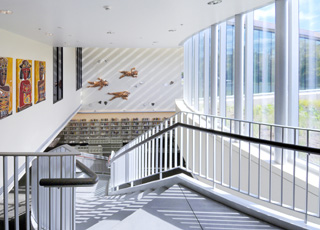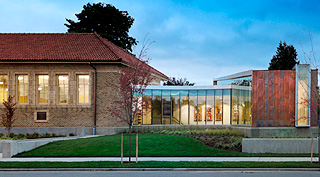
Surveys
DJC.COM
October 26, 2006
In with the old, in with the new
Schacht Aslani Architects

Photo by Mike Jensen The new section of the Douglass-Truth Library is connected to the old by a glass-walled hallway. |
Additions to historic structures present a significant design challenge for their owners, architects and community. Buildings designated as landmarks typically have strong architectural features and have played a visible role in the history of their place. Changing them to meet the demands of a contemporary program inevitably transforms the historic fabric of the landmark.
A key question is whether the new work should blend in with the original architecture or whether the design should clearly distinguish new from old.
The expansion of the Seattle Public Library’s Douglass-Truth Branch provides an example of the way in which a modern addition to a historic building preserves the character of the historic structure while creating an identity for its contemporary use and community.
In our community, the vast majority of additions to historic buildings have been designed in an aesthetic that blends with the original design. When form, materials and budget allow, the new work is often indistinguishable from the old. When the changes and the cost prohibit replication, the new addition is often designed “in the style of” the historic structure.
But, is this approach appropriate?
A design approach that tries to make the addition match the landmark may appear to be sympathetic but may cloud the identity of the historic building. A design concept that differentiates new from old may be a better preservation strategy, allowing the original architectural forms and materials to retain their identity and marking the cultural, programmatic and technological changes that have taken place over time.
A contemporary addition
The recently completed addition to the Douglass-Truth Branch, which expands the historic building from 8,000 to 16,450 square feet, is located on the east side of the symmetrical Carnegie-era library. The modern design language of the addition, with its glass and copper volumes, is a sharp contrast to the classical brick and terra-cotta language of the original.
The design for the Douglass-Truth addition stirred some controversy among architectural critics and a few members of the Seattle Landmarks Preservation Board. But the finished project has been well received by the community and the press. It is largely below grade, which scales it down in relation to the landmark and allows it to sit comfortably along one side of the original. Its new glass walls mirror the image of the old library.
The addition reflects the identity of a community that has changed significantly over time. The historic library was originally named after Seattle founder Henry L. Yesler when it was constructed in 1914. At the time, it was at the center of Seattle’s Jewish neighborhood and held the largest collection of printed materials on Jewish history and culture in the region.
As the city grew, the surrounding Central District changed, becoming the center of the African-American community. The library was renamed for Fredrick Douglass and Sojouner Truth in the 1970s. Today, it holds the largest collection of African-American materials in the region.
Rehabilitation standards

Mike Jensen Photo Expansion of the historic Douglass-Truth Library is a dramatic marriage of old and new. |
The U.S. Secretary of the Interior provides standards for the preservation of historic buildings. Standard 9 of the secretary’s Standards for Rehabilitation of historic structures speaks directly to the issue of the design of new additions to landmarks:
“New additions, exterior alterations, or related new construction shall not destroy historic materials that characterize the property. The new work shall be differentiated from the old and shall be compatible with the massing, size, scale, and architectural features to protect the historic integrity of the property and its environment.”
The contemporary design of the Douglass-Truth addition preserves the historic form and materials of the landmark structure. The glass connector between the new volume and the historic building sits below the main roof of the historic building. The historic red tile roof, with its broad overhanging eave and ornamental terra-cotta frieze, remains visible as it traces around the perimeter of the original structure. The point of connection between new and old is reduced to the smallest possible extent. One thousand of the 1,050 pieces of terra-cotta on the building were preserved.
The addition is clearly differentiated from the historic structure. Its glass and copper cladding lighten its mass in contrast to the solid, dense character of the masonry and tile roof on the historic building. This variation in material, detailing and color on the addition creates a distinction between the historic building and the new structure that maintains the classical proportions of the historic building. The copper clad volume over the new reading room and community meeting room serves as a light monitor. It slopes down and away from the historic building, deferring to the historic library’s primary place in the composition. The extensive glazing on the south and east elevations of the addition make it a mirror for the original building.
A record of place and time
The Standards for Rehabilitation speak to the way in which historic structures provide a record of the time and place in which they were built. Many of our landmarks are assemblies that developed over time, reflecting changes in their use and communities. Standard 3 addresses this issue:
“Each property shall be recognized as a physical record of its time, place, and use. Changes that create a false sense of historical development, such as adding conjectural features or architectural elements from other buildings, shall not be undertaken.”
An addition to a landmark building becomes part of the historic fabric. In the spirit of this standard, an addition should be designed in respect to its contemporary time, place and use so that it represents its cultural context and serves as a physical record for future generations.
The contemporary design language of the addition to the Douglass-Truth Branch speaks to the fact that it is a below-grade structure, a product of modern construction technology. It speaks to the advances in information technology represented by the contemporary library. And it speaks to the place of the library in the community — a landmark expressing the contemporary culture of the Central Area.
The contrast between old and new, between an early 20th century Carnegie-era library and its early 21st century addition, is expressive of the nature of the change that has occurred both in the Central Area and in the city over that time.
Walter Schacht and Cima Malek-Aslani are principals of Schacht Aslani Architects. Schacht is president of AIA Seattle. Malek Aslani is a King County landmarks commissioner.
Other Stories:
- Victoria project goes from brown to green
- Should design firms grow and change?
- Retail plays a bigger role in mixed-use
- Designers bet urban dwellers want more
- Dream team designs downtown penthouses
- Designing a cancer center for 4 competitors
- Healthy buildings’ role in organic modernism
- Queen Anne readies for icons old and new
- Keeping the bad guys out of banks
- Surviving today’s tough bid climate
- Why marketing during the good times is critical
- Getting creative with your feasibility analyses
- Hotels and condos: mixed-use matrimony
- School’s design reflects its humanist curriculum
- Seattle’s waterfront: 100 years of hidden history
Copyright ©2009 Seattle Daily Journal and DJC.COM.
Comments? Questions? Contact us.